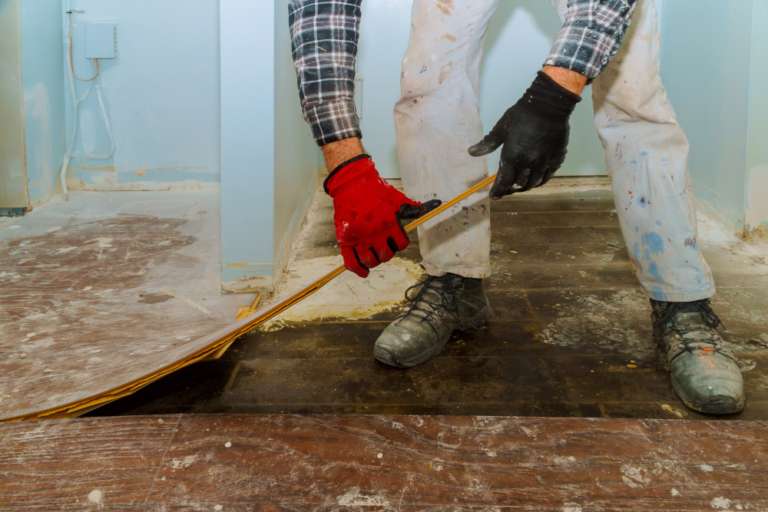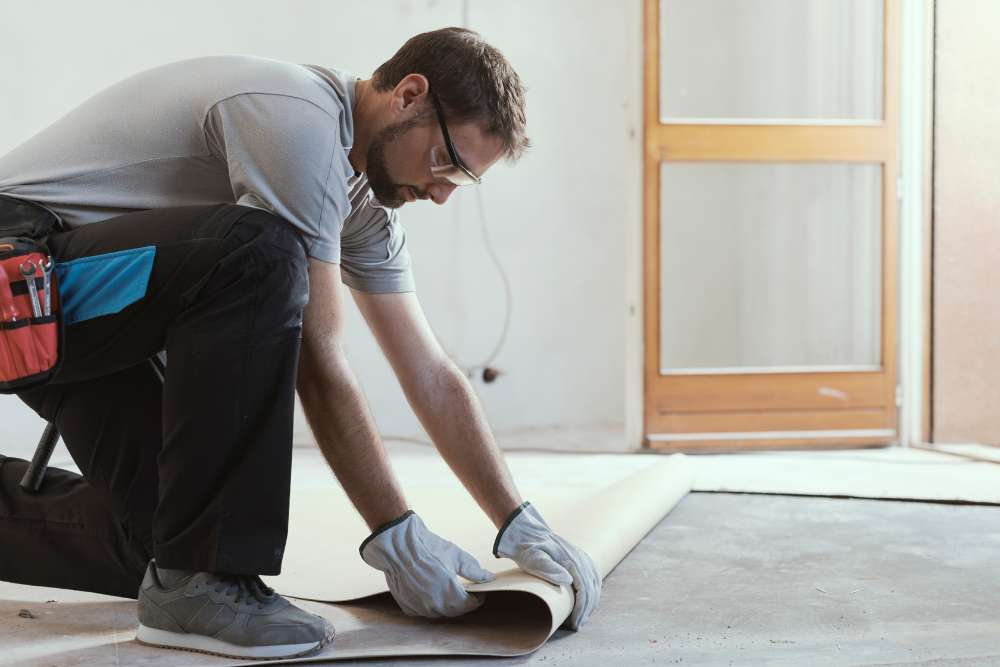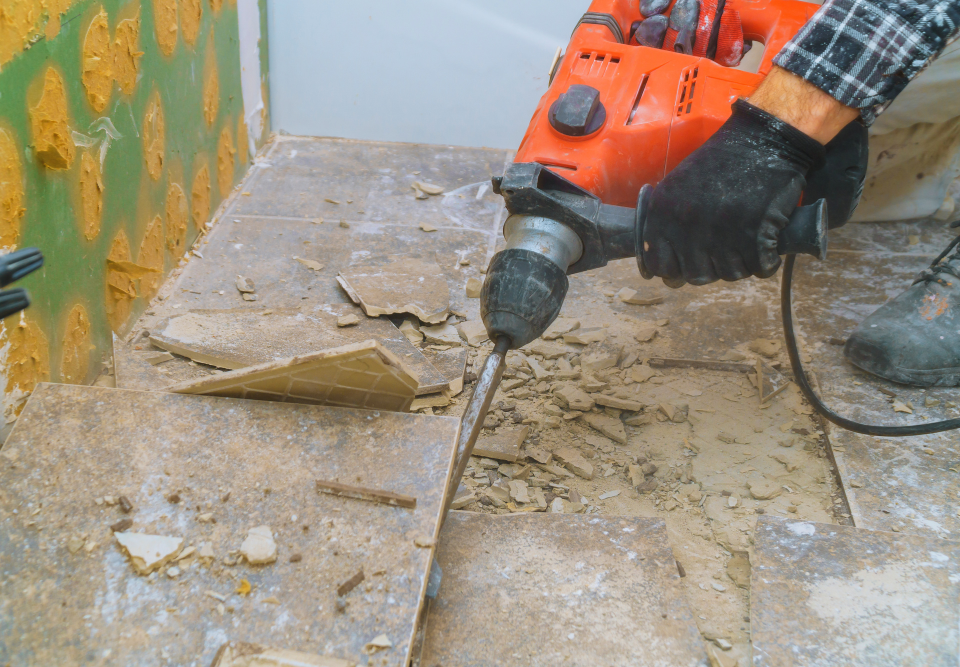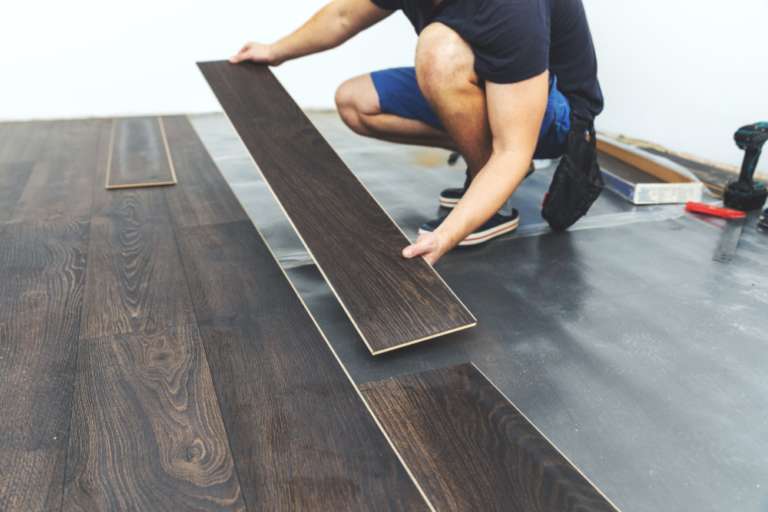
What’s Involved in Kitchen Demolition?
September 10, 2025
Demolition Cleanup Steps to Take After the Job is Done
September 10, 2025Best Practices for Flooring Removal and Disposal
Removing old flooring is one of those renovation tasks that looks simple at first glance but can quickly reveal layers of complexity. From hidden adhesives to unexpected subfloor issues, this process demands both preparation and patience. Proper disposal of old flooring materials is equally important, not just for convenience but also for the environment. Tossing everything into a landfill is rarely the best option. Instead, careful handling, recycling where possible, and professional hauling can make a big difference. Following best practices ensures that the transition from outdated flooring to fresh surfaces is smooth, safe, and efficient.
Preparing the work area before removal
A successful flooring removal project begins long before the first tile is pried up or the first board is lifted. Preparation involves clearing the room of furniture, rugs, and anything else that could obstruct the process. Covering nearby doorways with plastic sheeting also helps contain dust and debris, making cleanup easier later on. Safety gear like gloves, masks, and knee pads should be gathered in advance so no one has to scramble in the middle of the job.
Good preparation also includes inspecting the flooring type and condition. Hardwood, tile, laminate, and carpet each require unique strategies for removal. Identifying the materials beforehand avoids surprises and ensures the right tools are on hand. By laying this groundwork, homeowners reduce downtime and minimize the risk of damage to subfloors or surrounding structures. Proper preparation sets the stage for efficient removal and smoother disposal once the job is done.

Using the right tools for the job
Attempting to remove flooring without the correct tools often leads to frustration, wasted time, and even injury. For carpet, utility knives, pry bars, and staple removers are essential. Tile demands chisels, hammers, and in some cases, power scrapers. Hardwood and laminate may require circular saws to cut sections for easier handling. The right tools not only make the process faster but also reduce unnecessary damage to subflooring.
Investing in or renting specialized equipment is worthwhile for larger projects. For example, floor strippers can peel away adhesives more efficiently than manual scrapers. Shop vacuums equipped with HEPA filters help control dust during demolition. By ensuring that proper tools are available before beginning, homeowners make the work safer, cleaner, and more effective. A well-equipped project prevents setbacks and keeps the flooring removal process moving forward at a steady pace.
Handling carpet removal with care
Carpet may seem easy to remove, but it often hides layers of staples, tack strips, and padding that complicate the job. Start by cutting the carpet into manageable strips and rolling them tightly for removal. This makes it easier to transport and prevents unnecessary strain during hauling. Once the main layer is gone, the real challenge begins with extracting stubborn staples and removing tack strips carefully to avoid damaging the subfloor.
The padding beneath the carpet can present additional issues. Foam pads often crumble, leaving behind bits that must be scraped away. In some cases, adhesives secure the pad, requiring solvents or scrapers to remove it completely. Patience during carpet removal pays off by ensuring a clean, smooth surface ready for new flooring. Properly bundling and disposing of both the carpet and padding also streamlines the disposal process, reducing clutter and hazards on-site.
Tackling tile removal effectively
Tile removal is one of the most labor-intensive flooring tasks due to the strength of adhesives and the durability of ceramic or porcelain materials. The process often begins with breaking tiles using a hammer and chisel, then carefully prying them up piece by piece. Protective gear is critical, as shards can be sharp and hazardous. Once the tiles are gone, the thin-set mortar beneath usually requires significant effort to remove.
For larger projects, power scrapers or rotary hammers with chisel attachments speed up the process. However, care must be taken not to damage the subfloor beneath. Tile removal generates a considerable amount of heavy debris that needs organized disposal. Collecting broken tiles in sturdy containers or bags prevents accidents and makes transport easier. By approaching tile removal methodically, homeowners ensure a cleaner workspace and a smoother transition to the next phase of renovation.
Managing hardwood and laminate flooring
Hardwood and laminate present their own set of challenges during removal. Hardwood, depending on its installation, may be nailed, glued, or stapled, each requiring different techniques. Cutting planks into smaller sections often makes removal easier, especially with glued floors. Laminate, on the other hand, is usually a floating floor system that comes apart once the first row is lifted, but edges and transitions can be tricky.
Both materials often involve dust and splinters, so protective gloves and masks are important. Hardwood can sometimes be salvaged for reuse or recycling, making careful removal worthwhile. Laminate, while less valuable for reuse, should still be disposed of responsibly to avoid adding unnecessary waste to landfills. Knowing the difference between these materials and handling them accordingly ensures both efficient removal and environmentally conscious disposal practices.
Dealing with adhesives and subfloor preparation
After the visible flooring is removed, adhesives are often left behind as stubborn reminders of the old installation. Scraping adhesives can be tedious, but it is essential for preparing a smooth surface for new flooring. Heat guns, solvents, or specialized scrapers may be required depending on the type of glue used. Rushing through this step can lead to uneven subfloors that compromise the quality of the new installation.
Subfloor inspection also reveals issues that might have been hidden under the old flooring. Cracks, water damage, or uneven areas should be repaired before moving forward. Taking the time to address these issues ensures that new flooring lasts longer and looks better. Thorough adhesive removal and subfloor preparation are best practices that prevent costly mistakes later in the renovation process.
Recycling flooring materials responsibly
Many flooring materials can be recycled rather than discarded. Carpet fibers, certain types of hardwood, and even broken tiles can often find new life in other applications. Recycling not only benefits the environment but can also reduce disposal costs. Researching local recycling facilities before starting a project ensures materials are directed to the right place rather than sent to landfills unnecessarily.
Responsible recycling requires separating materials properly. For example, padding should be separated from carpet, and nails or staples removed from wood before recycling. Some recycling centers even accept adhesives or underlayment for processing. By committing to recycling where possible, flooring removal becomes a more sustainable process. Homeowners and contractors alike benefit from adopting eco-friendly practices that align with modern environmental goals.
Using professional junk removal services
Flooring removal generates large volumes of waste that can be overwhelming for homeowners to manage alone. Professional junk removal services offer a convenient solution by hauling away old flooring quickly and responsibly. These teams come equipped with the manpower, vehicles, and disposal knowledge to handle everything from carpet rolls to heavy tile debris.
Hiring professionals saves time and reduces physical strain, allowing homeowners to focus on other aspects of renovation. Many services also prioritize recycling, ensuring materials are disposed of in environmentally responsible ways. By choosing professional help, flooring removal becomes less stressful and more efficient. It also guarantees compliance with local disposal regulations, avoiding potential fines or complications.
Ensuring safety during flooring removal
Safety should be at the forefront of any flooring removal project. Old flooring materials often conceal hazards like sharp nails, splinters, or even mold and mildew. Wearing protective gloves, goggles, and masks minimizes exposure to these risks. Proper ventilation is essential, especially when adhesives or solvents are involved.
Using the right lifting techniques is also important to prevent injury. Flooring materials, particularly tile or hardwood, can be surprisingly heavy. Breaking them into smaller, manageable pieces reduces strain. Keeping the work area clean by regularly removing debris ensures clear walkways and prevents accidents. By following safety best practices, flooring removal becomes a manageable task rather than a hazardous undertaking.
Planning disposal logistics in advance
Disposal should never be an afterthought. Planning how and where flooring waste will be handled avoids last-minute stress. Renting a dumpster, scheduling professional junk removal, or coordinating trips to recycling centers should be arranged before removal begins. Knowing disposal costs and regulations in advance helps keep budgets on track.
Planning also includes determining how different materials will be separated. Creating designated piles or bins for carpet, wood, and tile simplifies recycling and disposal later. By approaching the project with a disposal plan already in place, cleanup becomes a smooth, organized process. This foresight ensures that the flooring removal is not only effective but also efficient and environmentally responsible.
Conclusion
Flooring removal and disposal demand careful planning, the right tools, and a focus on safety. From handling adhesives and preparing subfloors to recycling materials and managing disposal, each step plays an essential role in the renovation process. Overlooking these details can lead to costly delays or safety hazards, but following best practices ensures a clean and efficient transition to new flooring. Taking the time to prepare and organize disposal plans also helps protect the environment and reduces unnecessary waste.
For homeowners in Santa Rosa, CA, North Bay Junk Removal offers reliable junk removal services that simplify flooring disposal. Their experienced team ensures that debris is hauled away responsibly, whether it’s carpet, hardwood, tile, or laminate. By choosing their professional assistance, you can focus on the excitement of renovation while leaving the mess behind. Call 707-478-6817 to schedule junk removal services and keep your project moving forward smoothly.




